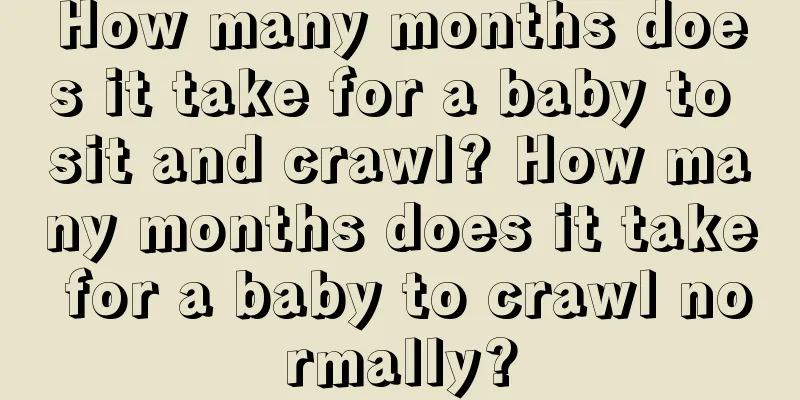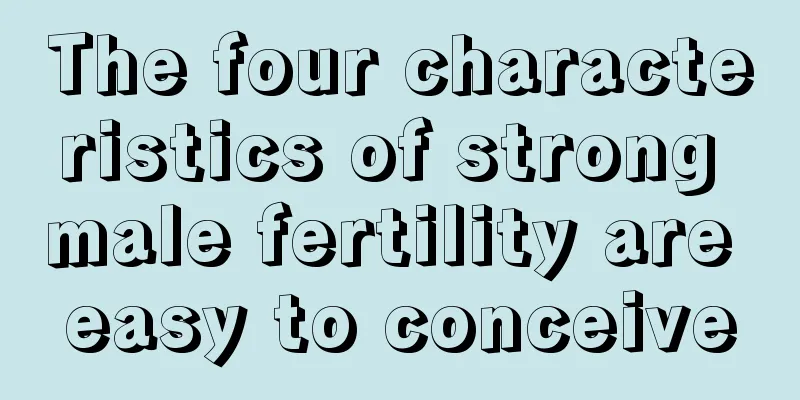How many months does it take for a baby to sit and crawl? How many months does it take for a baby to crawl normally?

|
After the baby is born, parents devote all their efforts to the baby. They often pay attention to the baby's development status. Today, let's talk about when it is normal for babies to learn to crawl. When will your baby crawl?1. When the baby is 5 to 6 months old, parents should prepare for the baby's crawling. He will lie on the bed, with his abdomen as the center, moving his body left and right, and gradually he will crawl on his stomach, but his abdomen is still close to the bed, and his limbs move irregularly, often not crawling forward but backward. At this time, parents should patiently guide the baby to learn to crawl correctly. 2. Crawling is a whole-body exercise for children. In addition to the participation of large muscle groups, small hands and feet must support the body to move forward. The small muscle groups of children's limbs are also exercised and developed, which provides conditions for the further development of fine movements in the future. Crawling also allows infants to develop their perceptual intentions, directional reasoning ability, and target-finding activities in advance. Crawling also promotes children's spirit of exploration and deepens their interactions with others. Normal babies of 3 to 8 months old can crawl. The development of infant crawling movement includes the following processes: hips are higher than heads, lower limbs are bent in place, hips and head are at the same height; two hands support, chest off the bed; forward movement of the upper body and backward crawling; forward movement of the lower body, gradually transitioning from belly crawling to hands and knees crawling; standard crawling, one upper limb and the opposite lower limb alternately extend and flex on the diagonal line to crawl; flexible forward movement, can crawl at will with two hands and two knees, two hands and one knee, two hands and two feet, etc. Completion of two-hand support (two elbows support and head lifting are the prerequisites for two-hand support); realization of hands and knees crawling; further improvement of upright and balance reaction; ability to change posture from belly crawling position to four-legged crawling position and then to belly crawling position; completion of four-limb interactive movement pattern; completion of single elbow support in side-lying position. Baby development stagesEvery baby's development is unique. The following times are averages. It is normal for your baby to develop earlier or later, so don't mind. Month 1 Prone, clenched fists, kicking legs, waving arms, responding to sounds, keen senses, blurred vision Month 2 Start learning to look up, discover your hands, occasionally smile, and have various emotional reactions Month 3 When lying prone, you can support your upper body and raise your head 45 degrees. Start to connect watching and doing. Month 4-5 Can roll over, laugh, and likes to look at himself in the mirror Month 5-6 Can sit independently for a while with support, can mumble to attract attention, can roll in different ways when lying down 6th-7th Month Can sit up by himself, can turn over flexibly, and has richer expressions Months 7-8 Starts crawling, makes more sounds, and improves his ability to understand adult language Months 8-9 Can stand with support, likes to hit objects that make sounds, and has more flexible hand movements Month 10 Able to stand up, walk occasionally, and drink from a cup Months 11-12 Able to walk with support, finger flexibility greatly improved, become active, able to speak simple words Months 12-15 Learn to walk, bend down to pick up things, have a strong curiosity, and can communicate simply Months 15-18 Likes to try to wash hands and face by himself, can squat freely, and can speak simple sentences Months 18-21 Able to move small objects, have good balance, start to try to solve problems on their own, and be able to express some of their wishes and requests Months 21-24 Able to do some things independently, such as washing hands, going to the toilet, etc.; hand-eye coordination ability is further strengthened; can do some simple housework, such as watering flowers, etc. Months 24-30 Dress and fold clothes independently; can also do some housework, such as wiping the table and shoes; language ability is further improved and can have conversations with others Months 30-36 Children at this stage can do tasks such as cutting, washing, and planting independently; they can use a variety of words to express their emotions; and they begin to take the initiative to say hello to their friends. How does a baby learn to crawl?Baby learning to crawl is divided into 3 stages There are three stages when babies first learn to crawl: some babies crawl backwards; some babies spin in place and only crawl without moving forward; others crawl forward on their stomachs when learning to crawl and do not know how to support their bodies with their limbs. This is all part of the baby's crawling process, so mom and dad should patiently teach their baby to practice crawling according to their characteristics. Usually, when the baby is 5 to 6 months old, he will prepare to crawl. He will lie on his stomach on the bed, move his body left and right with his abdomen as the center, and gradually he will crawl on all fours, but his abdomen will still stick to the bed, and his limbs will move irregularly, often not crawling forward but backward. Your baby may start crawling soon after he is able to sit up without support, around 6 to 7 months old. He will lift his head and look around. His arm, leg, and back muscles are also strong enough to support himself on his hands and knees without falling. Gradually (over the course of a few months) your baby will learn to move confidently from a sitting position to all fours, and he or she will soon realize that if he or she stretches out and keeps the body parallel to the floor, he or she can rock back and forth. Around 9 to 10 months, your baby will find that he can move forward by pushing his body with his knees. As he becomes more proficient, he will learn to move from a crawling position to a sitting position. He will even master an advanced crawling technique: the cross crawl, which is to move one arm and the other leg as he crawls forward, rather than moving the arm and leg on the same side at the same time. After that, with more practice, your baby will become proficient. By the time he is about 1 year old, he will be a very good crawler. Once your baby learns to crawl, there's only one step to full mobility: walking. To complete this final step, your baby will soon begin to stand up using anything within reach, whether it's your coffee table or your legs. Once your little one gets the feel for standing on his legs and keeping his balance, he'll be able to stand up on his own and take a few steps using furniture. After that, it's just a matter of time before your baby learns to walk, run, and jump. |
<<: What do newborn babies need to supplement?
>>: How to correct a baby's bowlegs? Can a baby's bowlegs be corrected?
Recommend
Will neonatal jaundice affect weight gain? Do neonatal jaundice require medication?
It is normal for newborns to suffer from jaundice...
What should parents do if their children hit others and steal toys?
How should we deal with disputes between children...
Will the fetal heart rate be normal if the fetus is hypoxic? Will the fetus still hiccup if it is hypoxic?
Pregnant women always pay attention to the condit...
Can I still have a baby with an ectopic pregnancy? Can I still have a baby with an ectopic pregnancy?
For mothers who want a baby, ectopic pregnancy is...
What should I do if I get pregnant while breastfeeding? Is there still milk during breastfeeding?
Many postpartum mothers enter the lactation perio...
How to name a cute baby boy nickname? How to name a cute baby boy nickname?
Babies are all very cute, so cute babies should o...
What are the good foods for children to eat to lose weight? What are the good foods for children to eat to lose weight?
Babies are the treasures of the family. They need...
What calcium tablets are best for children with calcium deficiency? What calcium supplements are best for children with calcium deficiency?
We all know that children need enough nutrition t...
How long does it take to recover from postpartum relaxation? How to recover from postpartum relaxation?
Generally speaking, pregnant women will experienc...
How to adjust the baby's late sleep How to correct the baby's late sleep
The baby's sleep is of concern to every paren...
What should pregnant women do if they have spleen and stomach deficiency? Does spleen and stomach deficiency in pregnant women affect the fetus?
It is very important for pregnant women to be in ...
Postpartum mothers tell their own stories: How painful is natural childbirth?
Most mothers choose to give birth naturally, but ...
How to prevent your baby from getting a cold stomach? Benefits of eating carrot puree for babies
The last thing parents want to see is their baby ...
Is it necessary to take early childhood education? Is it necessary for babies to take early childhood education classes?
There are now many early childhood education inst...
Can I keep the baby if I get pregnant after drinking? Does taking medicine have any impact on pregnancy?
Many people who have unexpected pregnancies have ...









